We experienced camera failure today but this proved to be another week with more than 23 pounds of lion’s manes harvested.
We experienced camera failure today but this proved to be another week with more than 23 pounds of lion’s manes harvested.
Summer always takes effort to keep these cool weather mushrooms happy.
As soon as we get through our current round of bags, we will perform our annual summer cleaning cycle. That will occur in less than two weeks.
We plan to be offline as briefly as possible as the demand for these is presently running high.
There were a lot of happy people in Ukiah on Saturday.
See you in Ft. Bragg today.
We had a harvest of more than 9 lbs on the 6th.
Another harvest of 7.6 lbs occurred last night.
And another harvest will occur late today. (It was more than 6 lbs.)
Lion’s mane harvests are still on the light side (4 kg were harvested from the two trays shown fruiting in the previous video) but despite that they made some people in Mendocino happy last week (and a couple in Ukiah). A light offering of our mushrooms will be at Ft. Bragg today and more at Ukiah on Saturday; with lots more to come and another round of bags scheduled to be opened and added today. We will also be at Mendocino next week.
Another week of mushroom growth; shown on Tuesday afternoon..
AND, while the next shiitakes to be harvested from our spawn bag production are still some weeks in the future, the first few shiitakes are beginning on some of the ricks that were plugged last summer.
We are looking forward to the 2018 Farmer’s Market season!
This year we will be sharing mushrooms with The Forest People so we will be offering each other’s mushrooms; our lion’s manes and their oysters respectively. One or both of us hopes to see you in Mendocino, Ft. Bragg or Ukiah at the MCFarm certified farmers market.
A look at the Hericium fruiting chamber today is below. It appears that we will be back at a steady pace again within the next two weeks.
The garden is gearing up for Spring also.
We will soon have gobo (burdock root) and will be bringing some incredible ha gobo leaves to the next farmer’s market. This has become one of our favorite greens. It has a flavor similar to collards but with a luscious velvety mouth feel.
After resolving a technical problem with our ISP, all of our web content and email occurring since the 26th of last July has vanished.
Some views of the Hericium fruiting chamber are below; taking us up to the point of a fungus gnat invasion in January. We shut down following that discovery (look for discolored or prematurely toothy fruiting bodies to see its beginning), decontaminated the entire facility, built another layer of entryway protection and are now in the process of refilling the chamber with bags again for 2018 Farmers Market.
New videos will be added soon showing our progress but for now here are some looks at our experience occurring between late July 2017 and January 2018.
Two weeks of growth: part 2 — 28 July 2017 IMG 2607
Two weeks of growth: part 3 — 28 July 2017 IMG 2620
Two weeks of growth: part 4 — 1 aug 2017 IMG 2622
Two weeks of growth: part 5 — 1 aug 2017 IMG 2642
Two weeks of growth: part 6 — 5 aug 2017 IMG 2661
Two weeks of growth: part 7 — 9 aug 2017 IMG 2676
Hericium erinaceus 2018 January 04 IMG 5042
Hericium erinaceus 13 Jan 2018 IMG 5335
Hericium erinaceus 19 Jan 2018 IMG 5793
Hericium erinaceus 25 january 2018 IMG 5959
Today was a great day for lion’s manes.
This was the view just before harvest:
I noticed some minor water drippage problems that I need to fine tune as I lost a couple of mushrooms to it. Check out the upper side of this beautiful lion’s mane. Notice that grey spot? This otherwise nice looking mushroom is unsaleable because of that.
Off the subject of lion’s manes for a moment, I was surprised to see this Pleurotus fruiting on a familiar Hericium tree.
This gorgeous lion’s mane (Hericium erinaceus) was not as much of a surprise since this is the sixth year for this spot but it did surprise me by being so early. Around now has been more typical to find it at a much earlier stage of growth. Hericium coralloides has also been abundant on this same fallen trunk during those same years but it won’t get going until after it gets cold.
We can’t sell wild Hericium erinaceus in California but we sure do enjoy eating them.
We made a small harvest for market in between these two sets of images but thought it would be of interest to see some paired images from 30 September and 1 October as they show how fast lion’s manes can grow.
Lion’s manes will be available again soon; beginning with next week’s Boonville Farmer’s Market.
We will also have a few shiitakes, assorted tomatoes and some amazing potatoes.
We look forward to seeing you there.
We are clearly fast approaching the point of establishing the maximum production capacity of this fruiting chamber. The blobby mushrooms are all young Hericium americanum.
(https://www.youtube.com/embed/7Onw0aN1hYI)
The CO2 level is still running a little high (650 ppm) but I’m hoping to have that dialed in within the next couple of days by adding a larger vent fan (replacing one of the existing ones – a 4″- with a 7-inch inline exhast fan).
RIght now it is where we want (between 450-500 ppm) only until the chamber gets more than half way full. Preventing the massive spore load from clogging the insect screening has also become a recurrent maintenance task as the accumulation of spores plays a major role in interferring with good air exchange. The air inside of the fruiting chamber is completely replaced with fresh air six times every hour.
It is actually the 4th of December and I had hoped to post this pair of youtube videos a few days ago so am editing an older post.
The first view was following a harvest and the beginning of another round of open bags. Some from the previous round are still going and on their second flush.
This was the view on 24 November.
There is another video at youtube that was taken in between those. The camera had become lost and does not reliably date media so the day it was taken is unclear but was likely on the 21st or 22nd of November.
Hericium erinaceus 24 October 2015
Cultivated: 167 grams (1/3rd lb.)
Hericium erinaceus 1 November 2015
Wild: 730 grams
We can’t sell wild mushrooms but we certainly do eat them! Part of this one was delicious last night cooked with chicken and vegetables.
And there was another Lion’s mane that was found today (2 November). Harvesting mushrooms such as this one can be potentially dangerous.
I did not manage to bring this one down as a single, 791 gram, piece.
There was another one above it that was easily 30+ feet higher on the tree (so it was safe from me).
A Chinese adage is good to keep in mind considering Hericium erinaceus eats trees:
“Fools and smoke like to climb high”
This is that same tree when I checked it a month ago (5 October)
What goes into our mushrooms is really simple.
We start with tan-oak (Lithocarpus densifolia) sawdust from the local business Frank’s Firewood.
Frank is in the business of producing and selling firewood but that process creates a lot of great sawdust which is perfect for our needs. Frank refuses to take in any trees that have been killed or treated with herbicides.
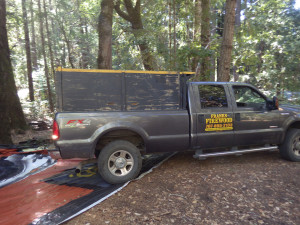 |
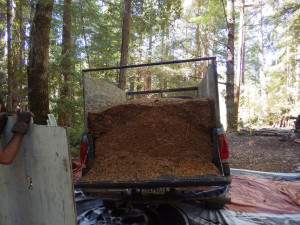 |
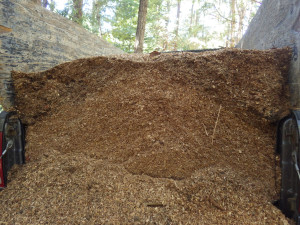 |
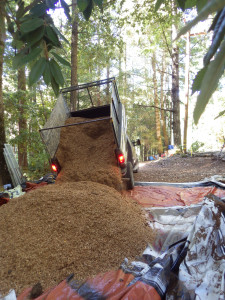
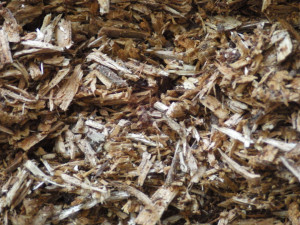
To that is added organic wheat bran and the highest-quality pure gypsum that is considered to be ‘organic’. We are not presently recognized as organic producers but do our best to include only pure ingredients.
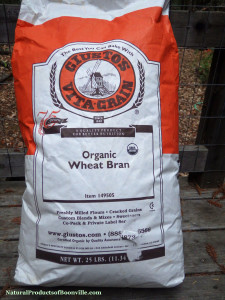 |
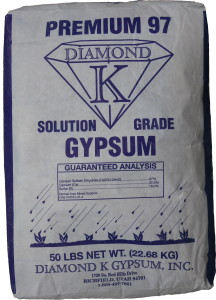 |
When we make spawn, we use organic rye grain. If we order commercial grain spawn it comes from a certified organic producer.
The only other thing that we incorporate in the recipe for our mushroom growing media is the high-quality water from our protected well.
We are taking it one step farther and as of late February 2016 will be using only organic nonGMO dextrose which is derived from grapes and imported from Italy thanks to Naturalia Ingredients and Ciranda. There was so much difficulty locating organic dextrose that we have decided to offer small quantities at reasonable prices to other mushroom producers who are wanting to use entirely organic ingredients.
Lion’s mane are delicate and fragile mushrooms that can bruise easily (compare ours to those from other producers). To minimize handling, and any bruising or discoloration, we carefully pick each individual Lion’s manes using a bakery tissue and gently nestle them together loosely. Most mushrooms, such as shiitakes, don’t require that. Whenever possible all of our mushrooms are harvested directly into their resale packaging. Boxes such as the one below promptly go into refrigeration to ensure you of the longest possible shelflife.
The most important thing we put into the production of all of our mushrooms is a lot of love.
Simple is good.
Our summer maintenance is complete and everything is just beginning to gear back up towards full production.
The conditions inside are as close to being perfect as I could want for keeping the lion’s manes happy.

Carbon dioxide level & temperature meter |
The Lion’s manes are doing great. They even permitted a small harvest for last weekend’s Farmer’s Market.
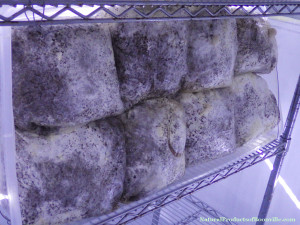 Getting ready to fruit; two have small ones already
Getting ready to fruit; two have small ones already
The outside temperatures cooling off at nighttime lately triggered a log to fruit. You can see why we’ve grown fonder of bag production as it leaves the mushrooms really clean by comparison.
We hope to see you at Saturday’s Farmer’s Market in Boonville.
Held Saturdays from 10AM-1230PM in the Boonville Hotel parking lot until the end of this month.
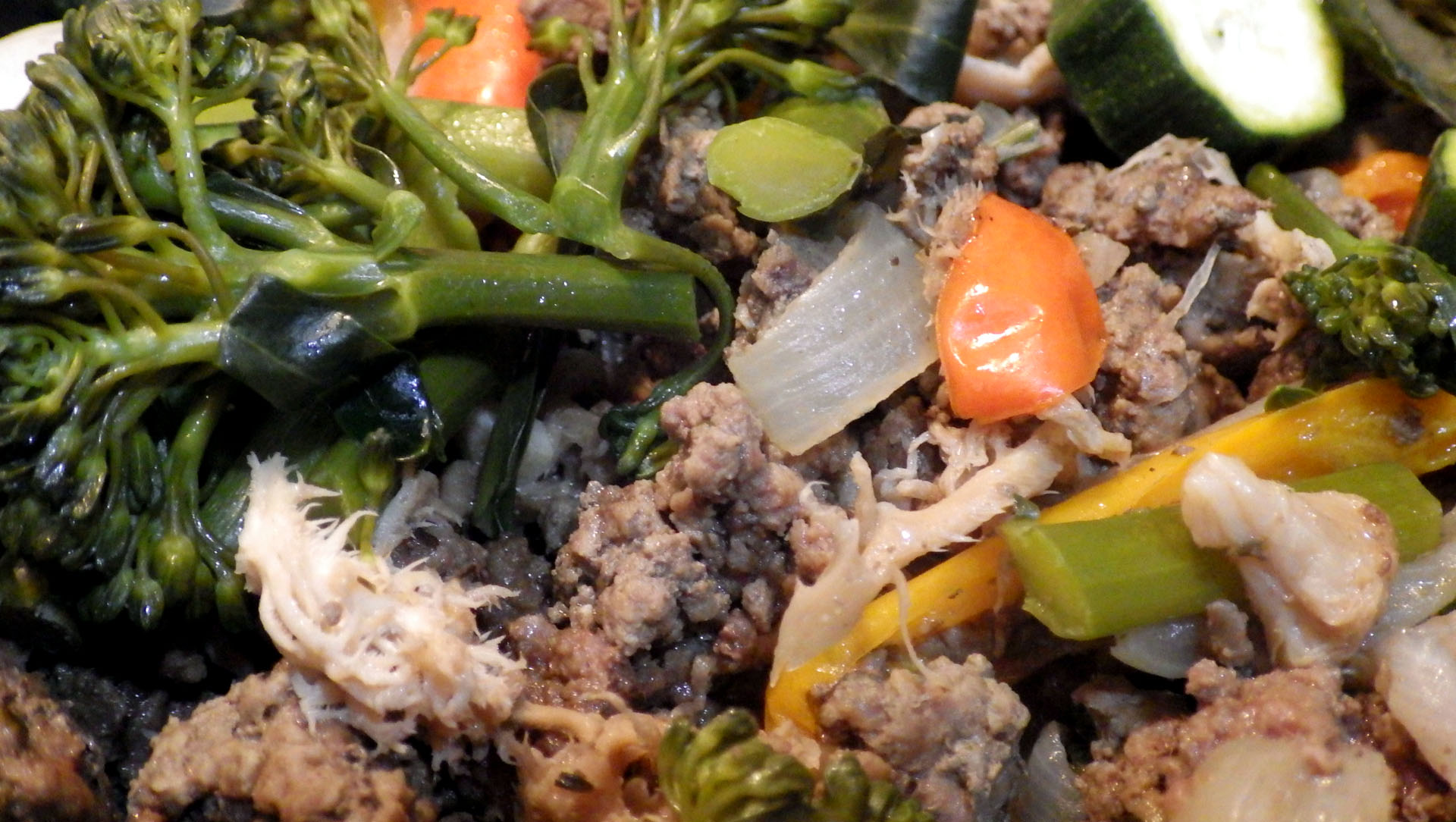
Downloadable PDF version of this page
There are many ways to cook the Lion’s mane (Hericium) mushrooms.
My favorite two:
1) Cut into 1/2 inch slices or if solid and very large the slices also get re-sliced into 1/2” wide strips. Some people prefer to tear them into pieces. Try both approaches to discover which you like best.
Wild harvested mushrooms, including Lion’s mane, will usually go into a dry fry pan at the beginning to ‘sweat out’ a lot of liquid (and flavor). which will then take a few minutes to reduce and be re-sorbed back into the mushroom (usually 6-8).
If the hericiums were cultivated, or if they were wild harvested during periods of non-rainy weather, they usually need a few tablespoons of water to be added at first (and occasionally more later) to prevent scorching.
If oil is used it should be only enough to prevent sticking. Too much results in frying the mushroom. Ideally just small bits of water should be used at this point.
The mushrooms should be started on a medium high heat and cooked for around 1-2 minutes with stirring — just to get them completely hot quickly, then the heat should then be reduced to medium low or low and they should be cooked covered for another 15 minutes with occasional stirring. Halfway into the cooking add a small amount of butter or a 2:1 mixture of olive oil and butter.
Wine or other optional liquid seasonings should be added only towards the end of the cooking process or they can be absorbed to the point of obscuring the delicate flavor of the lion’s mane.
2) Start out the same as above but add the butter and/or oil much sooner, as soon as liquids have been resorbed by the mushrooms. (be sure that all excess liquid has been resorbed before adding butter/oil) and cook over moderate heat until the edges and teeth begin to get golden-brown and crunchy. This will require a bit more oil than the first method plus very close monitoring towards the end, to avoid scorching.
All Hericium mushroom species freeze well once cooked. They can be prepared when available, packed into half-pint jars, and frozen for use at another time.
Thinly slice or dice a medium onion and a largish clove of garlic.
Lightly cook in a frying pan in oil. I greatly like a blend of Avocado oil and roasted garlic olive oil.
Add 1/2 dozen baby bell peppers cut into quarters.
When the color of the onions and the peppers begins to change, turn over and add 1-3/4# organic boneless chicken thighs, approximately 2 cups of (four medium sized)
potatoes or the equivalent in small potatoes, roughly same amount of Hericium as potatoes (cut into 1/2 inch sections; or if large the slices should be resliced into 1/2″ wide strips) approximately two cups once chopped. I like to add one or two slices of butter at that point as well.
Cover and cook on medium-low to medium heat until the chicken is done. Usually 15-20 minutes.
Salt and/or pepper to taste, if needed.
Hot peppers may be added with the bell peppers if heat is desired and the chicken may be omitted if a vegetarian dish is desired.
If the chicken is omitted more monitoring is required and a few tablespoons of water may be needed in order to prevent scorching of the vegetables.
Cook them in good oil such as butter, olive-oil:butter, avocado oil, etcetera until the slices are limp.
Shiitakes are versatile. They can be stir fried, baked plain or stuffed, marinated and grilled, added whole to the vegetables that get cooked along with a roast or in an earthen oven, added to soups, stews or meat dishes, or they can be cooked alone and enjoyed as dish. Precooked shiitakes can also then be combined with other foods such as omelettes, vegetables, soups and salads. It may be convenient to cook enough mushrooms for adding to 2 or 4 meals. Cooked shiitakes freeze acceptably.
Butter, garlic & a little salt may compliment shiitakes own distinctive flavor.
Stems of shiitakes are most often fibrous and very tough. They should be removed before cooking.
Thicker stems can be very thinly sliced and fried until golden brown in butter or butter and oil for a crispy-to-chewy treat. Thinner, tougher stems can be dried and ground into a powder for later use as a thickening agent in soups, stews, stock reductions and many types of sauces. Or stems *can* be discarded.
Slice shiitakes thin but not too thinly. A couple to several (2-4) mm is fine. Try to slice them evenly.
Place the slices into a bowl and add a minimum amount of your favorite cooking oil then gently stir extremely well. A variant of this is to spread the slices out on a cooking sheet and lightly mist with a light spray of oil before tossing to coat all surfaces. It is important to not use too much oil.
The goal is to get a bare minimum but thorough coating of oil on all of the mushrooms. A special touch can be created by adding a drop of liquid smoke to the oil and shaking very well before oiling the mushrooms.
Once this is done lightly season with sea salt and again mix thoroughly. Other seasonings can also be added but keeping it simple has great results.
Spread the shiitakes out into a single layer on a foil or parchment paper lined baking sheet. Sprinkle the top with coarse sea salt.
Bake in a preheated 350°F oven, checking frequently, especially towards the end.
You want them to cook completely dry, turning brown with some golden parts. This takes a few minutes (15 or more minutes is common; the hotter the oven the faster it goes but monitor them carefully as rotating the pan may be required in some ovens. The last few minutes of this goes very fast so it requires a close eye to prevent burning.
Using care, transfer the baked mushrooms from the hot sheet into a bowl.
Let it cool and you now have a bowl of shiitake bacon.
Break some crunchy dried sea palm fronds into smaller pieces & toss with your shiitake bacon. Enjoy.
If you are an optimist this can be packed into a jar and placed into a refrigerator for storage. If you are a realist you will probably leave it available on the counter knowing it will be consumed very quickly.
Caution: this food item may be found to be compulsively addictive.
Approximately one in 50 or more people appear to have a sensitivity to uncooked or undercooked shiitakes. Most shiitakes consumed in the world are dried and then rehydrated; drying is not the same as cooking and a thorough cooking is still needed.
In those rare individuals who are allergic, consuming undercooked or raw shiitakes may result in a skin rash resembling poison oak but accompanied by characteristic scratch-like lines (“flagellate”). If there is an allergic reaction, the rash begins 24-72 hr following ingestion and can last for up to 14 days. It resolves spontaneously without any treatment but a doctor can shorten its duration.
Most people are not allergic. Thoroughly cooked shiitakes appear to be OK for everyone.
Our shiitakes are finally getting going again!
This first small round of bags is showing some signs of heat stress but they are just the beginning. The new fruiting chamber should be able to keep the shiitakes cool enough to stay happy this summer. It just came online within the past few days.
A peak inside of the Hericium fruiting chamber.
Just a look at a few of the mushrooms that are going to the Farmer’s Market tomorrow (16 May 2015).
Some Hericium americanum (compare these to a few days ago).
For a sense of scale, those bags are 9 inches wide.
This smallish one was really anxious to get some spores out.
The tray on top is regular Hericium erinaceus lion’s manes that will start putting on fruit in the next few days. The row below that are the Hericium americanum that are being harvested this week.
These bags are merrily incubating and will be ready to open for fruiting in another week.
I’m not just saying that as a figure of speech. I really love the experience of eating, smelling, touching, seeing or just being near any of the Hericiums.
The new fruiting chamber is working very well. Fine tuning the misting is still ongoing but the lion’s mane mushrooms all really love it in there.
These images show a few of what was fruiting today. For some reason I failed to take photographs of the last two lots which were harvested and delivered within just the last few days.
Bags that were opened but which are showing no fruit in these images were either just harvested on Thursday and Friday or else just entered the rotation and will begin fruiting within this week.
Lots of learning is still ongoing. For example I’ve found that if I make cuts in the bags that are too large, a little bit of the sawdust and/or grain media ends up on the back of the mushroom. Not a big deal but it is also avoidable. If I make them too small, the fruit can spontaneously fall off as it gets big. If I do it just right, they almost want to drop into my hand with a very clean separation.
Alternating cycles of intense heavy fog with periods that drop to 85% relative humidity has also been appreciated by them. I’ve also increased the total chamber venting time by 8 minutes per hour due to the CO2 level increasing as the chamber started becoming more filled with bags. Exhaust fans vent the air six times every hour.
I’ve read that lion’s manes don’t like light during colonization. I’ve even grown them that way. They do fine starting in total darkness (and also do fine with ZERO supplementation) but grow much slower and take longer before their first fruiting. They seem to appreciate loght and they grow a lot better with it. As soon as they are on sawdust, the incubating bags here currently experience a 10/14 day/night cycle. I’m still learning so this ratio may change. Light also noticeably contributes positively to mycelial growth. Light does add some problems for the same reason it has value though due to the risk of the LED cables behind the trays stimulating growth through the filter patch leading to fruit forming and becoming trapped behind the bags. The precautions against light also have value for decreasing the incidence of microfruiting of Hericium on agar and grain.
The Hericium americanum are starting to really develop. I’m not sure if I am going to wait until the teeth develop or not. One that I picked and added to dinner as a test was great.
This Hericium coralloides was delicious.
Lots of Hericium erinaceus have been fruiting
And “Shanti”, a really nice multilobed Hericium erinaceus variant, is also growing very well.
Comments about our cultivated Lion’s mane mushrooms
Why do we only sell cultivated Hericium?
Why not add some *wild* harvested Hericium?
It is certainly possible to harvest the Hericium species and many other mushrooms from the wild. Both of us have been avid foragers of wild mushrooms for some years now, to be part of our own diet, and we consume a rather substantial quantity of wild Hericium species every year, but we sell only cultivated mushrooms.
There are many benefits of mushroom cultivation.
A few of those include:
1) a predictable supply that is not based on lucky weather, seasonally limited fruiting periods, and the timing of visitation all coinciding productively,
2) the ability to harvest only the highest-quality mushrooms at their peak,
3) knowing that they are free from molds,
4) the ability to prevent excessive moisture content (a frequent challenge with wild lion’s mane especially when large),
5) the production of fungal bodies that are clean (rather than containing forest debris, and many tiny beetles , fungus gnats, their larvae, and mites, often inside of the mushroom’s tissues, as is quite common with wild-collected lion’s mane),
6) much greater personal safety during harvesting; compared to climbing or otherwise recovering fruiting bodies from a rotting tree (& it completely avoids the uniquely unpleasant but harmless experience of “catching” a large falling lion’s mane with one’s forehead),
AND
7) there is the added benefit of control over the ingredients of the media; ensuring the least possible risk of any type of heavy metal accumulation.
That last point is an important concern about which many people appear to be aware.
We commonly associate heavy metals with industrial pollution and can forget that potentially toxic elements such as lead, mercury, cadmium, nickel and arsenic are not uncommonly natural and normal minor components of rocks and soil. Many of the edible mushroom species appear to have the ability to accumulate one or more of these metals IF they are present and bioavailable in their surroundings.
Cultivation permits the grower to know, within reason, exactly what is contained in their growing media and minimize that risk. In the EU, maximum permissible levels of heavy metals have been established for both wild and cultivated mushroom species that are sold to the public. The USA lacks regulation in this particular area.
How mushroom cultivation works (a more detailed pictorial will be added here in the future):
All media (whether liquid culture, agar, grain or sawdust) is first cooked in a pressure cooker in an attempt to kill any potential contaminant prior to the inoculation. The inoculation work is performed in front of a hepafiltered flowhood that temporarily creates a clean, almost sterile, working space as the resulting filtered air-flow is free from microbes and mold spores.
Cultures of the edible mushroom species are far more often produced by cloning than from spores. The reason is simple; spores produce a broad range of individuals with different performances and yields. A commercial mushroom producer needs to select for only the most vigorous and productive of those in order to be a successful farmer. Once a good performing clone has been identified and proven by growing it out through the entire fruiting process, future propagation focuses on inoculations using that same clone line. Most, perhaps all, professional cultivators keep an eye out for unusually nice fruiting bodies that might provide a lineage of good production for them.
Clones are created by taking a small piece of tissue from inside of a living mushroom and transferring it to a sterile culture medium of some sort.
Commercial sources exist for Hericium erinaceus, and up to three other species (H. americanum, H. clathroides & H. coralloides). They are variously available as mycelial cultures on agar, in petri dishes or slants, and in liquid culture, as well as grain spawn, sawdust spawn intended for plugging logs, hardwood dowels colonized with mycelium, and sometimes even precolonized on sawdust cakes ready-to-fruit.
The growth of cultures that are intended for production are often begun on either agar in a petri dish or in water in a jar that has a filter disk for a lid — either one containing a low concentration of a source of sugar such as dextrose or light malt extract.
This can then be repeated once the colonization has taken place and small portions of the mycelium can be used to inoculate additional plates of agar or liquid culture or at some point either can be transferred onto grain.
Each jar of colonized grain can potentially then be used to inoculate more jars of grain. The endpoint for those jars of grain is that they are eventually used to inoculate a number of bags of sawdust that have been supplemented with wheat bran and a mixture of gypsum and oyster shell.
After the bags are inoculated, they get to luxuriate in the cool, moist, protected environment of their fruiting chamber (an insulated shipping container with filtered air and good pre-conditioned ventilation). As soon as the bags are colonized, small cuts are made in a couple of spots to permit the fruit to form on the outside of the bag.
The fruit tends to naturally occur most often on a vertical surface, or even under a negative incline, rather than on top of a horizontal surface. This particular run pictured below is evaluating the yield from a top fruiting arrangement.
A short tour of the Hericium fruiting chamber:
Our favorite time to harvest is when the teeth have just started. The texture is nice, the taste is mildly almost sweet and the shelf-life is longer.
This name, “Hericium erinaceum”, is a misspelling.
Many culture banks, herbarium data-bases, the National Checklist of Taiwan, the Atlas of Living Australia, a number of patents, assorted publications in analytical, medical &/or nutritional research and even a few mycologists employ the name “Hericium erinaceum (Bull. : Fr.) Pers.” Sometimes this name has appeared in molecular work alongside H. erinaceus. Sometimes it is given as the accepted name. It is however an error that now comprises a substantial minority of the locatable instances of use.
The name being misspelled “erinaceum” originated in the literature as a typo made in Persoon’s 1818 Traite sur les Champignons Comestibles (on page 251).
Persoon had earlier employed the spelling erinaceus in 1794 (in Roemer’s Neues Magazin für die Botanik, page 153); also in 1797 (Commentatio de Fungis Clavaeformibus, page 27), and in 1801 (Synopsis Methodica Fungorum, page 560) and he did so again later in 1825 (Mycologia Europaea, volume 2, page 153).
1818 was the only instance in any of Persoon’s works using the spelling erinaceum. Due to his respected stature as an authority and the nature of the work that it appeared within, his error has achieved some lasting power through its retellings.
Persoon’s 1818 entry itself supports his spelling as erinaceum being made in error. In this book, all of the authorities included by Persoon had spelled it erinaceus. Persoon had cited Bulliard 1797 (see page 304 and plate 34), Paulet 1793 (see plate CXCIII) and Trattinnick 1805 (see page 191). Persoon 1818 may have been the first appearance of the error but sadly this spelling was picked up by a minor portion of active authors from that time period onward.
Due to a minor number of prominent workers across several disciplines missing or not questioning the error, with some perhaps regarding it to be a correction of gender by Persoon, today a Google search will reveal erinaceus : erinaceum are currently both in use at a 28:1 ratio, with respectively 948,000 vs 33,800 results. In some of the latter instances both names are presented to be synonyms but “erinaceum” is actually quite easy to find used in the analytical and pharmacological literature. The GBIF database shows erinaceum with 39 entries and erinaceus with 1559. It is especially common in Asian publications and databases; possibly due to databases such as the Lai 2012, Atlas of Living Australia and Cybertruffle presenting it as the accepted name for the species.
In some instances erinaceum and erinaceus have even been evaluated in studies as separate taxa.
Serendipitously, Park et alia 2014 compared specimens bearing both names in a molecular study and reported differences between Asian erinaceum and US erinaceus.
More work is clearly in order but the application of Latin binomials does have some clearly defined rules.
Despite that there is a peculiar hurdle in this instance. The origin of the problem arose from a leading authority, Persoon, putting a misspelling into print and this error then being repeated by a few other respected authorities. That is an unfortunate combination that creates long-lasting perpetuations which are often highly resistant to correction.
Competent mycologists are included among those who have used, and in a few cases still use, the name. While Cooke 1871 used erinaceus, his successors, Stevenson 1886 and Massee 1892 changed it to erinaceum. In 1978, Burdsall et alia (Mycotaxon, 7(1): 1–9) attempted to describe a mushroom they encountered as new taxa Hericium erinaceum ssp. erinaceo-abietis.
Burdsall commented that Harrison 1973 (Michigan Botanist, 12: 177–194) had recognized Hericium erinaceum as one of the accepted Hericium species. Harrison had actually used the spelling erinaceus and never mentioned erinaceum.
Some of the resistance to correction may involve workers trying to match genders of the suffixes without understanding why the word choices are what they are. Misperceptions of erinaceum as a correction of the gender no doubt helped perpetuate it.
Henderson 1981 helpfully made the comment that “”hedgehog” has the masculine ending “-us” even though Hericium is neuter, because “erinaceus” is a noun rather than an adjective.”
Erinaceus europaeus is the European hedgehog.
[In Latin, the nominative form of the noun is erinaceus and erinaceum is the accusative form.]
Many authorities and databases, have noted erinaceum to be an orthographic variant (i.e. a name with a spelling that entered the literature as a typo or other mistake).
Fortunately the International Code of Nomenclature for Algae, Fungi, and Plants (currently the Shenzhen Code 2018 — Turland et alia (eds.) 2018) includes some clear and simple provisions for what taxonomy is supposed to do with such orthographic variants:
61.1. Only one orthographical variant of any one name is treated as validly published: the form that appears in the original publication […] [See the Code for the acceptable exceptions to this rule.]
61.4. The orthographical variants of a name are to be corrected to the validly published form of that name. Whenever such a variant appears in a publication, it is to be treated as if it appeared in its corrected form
If only reality worked so simply…
Nothing new or original from me here as far as the use of filter disks on jars or using jars for agar.
This is something that has been a valuable tool in maintaining and growing Hericium clones.
Holes were made using an art crafter’s thin-metal hole-punch and installed with the side shown facing down so heating does not seal the edge shut.
Standard heavy filter material as is used in the fungal production industry.
It is some sort of thick porous plastic that holds up to pressure cooking. Looks and feels like it could be polypropylene but I am not sure. Comes in sheets that are most often sold in precut circles. There is some art stock that looks very similar but if held to the light tiny specks of sky are visible through it so it is not the same thing.
Agar that has been shaken cold and quickly poured.
(These could have been poured using hot agar but this is way faster and simpler.)
This was a PDYA so required a lot of swirling during the pouring process and still had a fair amount of excess settling in the last jar.
Used:
18 grams Uncle Ben’s Instant Potato Flakes
14 grams of bacteriological grade agar
3 grams of dextrose
1 gram of Diamond-V yeast extract (Don’t mistake dark spots as contaminants later!)
750 ml water (tap water which is nonchlorinated from a protected well)
Metal foil just keeps filter disk from getting saturated and potentially compromisable.,
These get stacked in the PC and cooked for 25 minutes at 15 psi.
A cooked bag straight out of the PC can be seen on the left.
Jar on far left above shows settling due to setttling challenge when starting with cold agar. It has never caused problems and generally only affects the last jar poured.
This is a rather high priced way to make agar plates compared to petri dishes.
For long-lived cultures like Hericium they can be quite valuable as the thick agar lasts longer before drying. And there is enough room to prevent breaching the container if the Hericium forms microfruit.
Plus these can go straight into a refrigerator and enjoy Winter even if it is the dead of summer. This is how we keep our working cultures alive and happy during summer heat (we also maintain master slants).
They have also proven to be a good tool when cloning Hericiums but the tissue selection is the most important aspect. If it is not both clean and not-at-all waterlogged another choice should be made if possible. It is feasible to get clones from soggy material but they typically require a lot of time and effort to chase clear of molds and other contaminants. This problem is dramatically reduced or eliminated when starting out with a good tissue sample. Inside of thick sections of branches or inside of the basal sections have given great results as have the use of branchy tips from microfruit forming inside of jars or when fruiting has occurred inside of a bag.